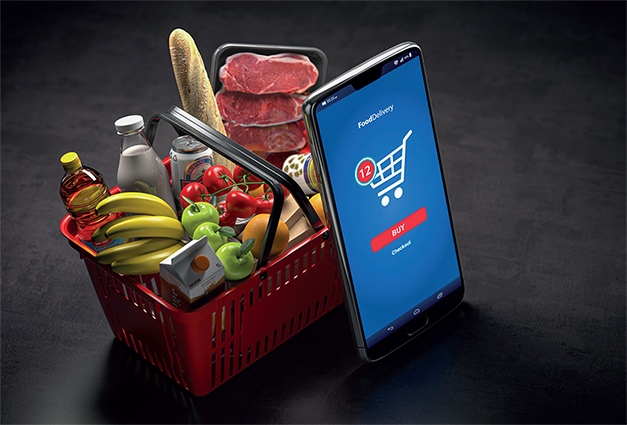
Pick, pack, and deliver
The grocery industry has had a bumpy ride over the last few years. Whether it was empty shelves during the pandemic as customers scrambled to stock up on essentials, the impact of Brexit on the likes of legislation, import fees, and the time it takes to get goods across Europe, or the increased supply chain and labor costs currently being passed on to the customer; the price of standard grocery items has been adversely impacted significantly.
Research from McKinsey found the words grocery CEOs most commonly associate with their expectations for the market are ‘challenging,’ ‘uncertain,’ ‘price-focused,’ ‘competitive,’ and ‘online’. When it comes to the UK grocery sector, these adjectives could not be more accurate. We anticipate the uncertainty will continue over the next few years as the industry and economy find their feet following the pandemic.
To survive, retailers need to navigate the tricky balance between increasing sales, managing costs and retaining customer loyalty, and now is not the time to make a mistake.
A change in habits
The same McKinsey research found that scaling their online grocery business featured in the top three priorities of 50 percent of CEOs. The drivers behind this are clear. The pandemic forced many consumers to purchase their groceries online. In March 2020, for example, at the very beginning of the pandemic, Tesco delivered 600,000 orders per week, while in March 2021, when the UK was still in a lockdown, it reached 1.3 million weekly deliveries.
Even as we settle into life after the pandemic, consumers continue to purchase their groceries online. And almost all grocery retailers in the UK have started to see this opportunity and the necessity of online retailing. Asda’s CIO, Carl Dawson, recently claimed that “omnichannel is at the heart of our strategy and customer proposition, where we want to provide a great customer experience and a seamless user journey.”
Businesses must continue to invest in their eCommerce offering, but what areas should they invest in to capitalize on this opportunity and overcome many of the obstacles they’re currently facing?
Managing orders in the most effective way
An important area of investment should be an effective order management solution (OMS). Historically, retailers have struggled with order management systems due to the lack of real-time visibility to external events or disruptions, labor, and material shortages – problems with which today’s retailers will be all too familiar.
Through the right technology and intelligent use of AI and machine learning, however, retailers can access and provide real-time insights that optimize the entire click-to-deliver journey, starting with an engaging customer experience through to efficient order fulfilment.
This will help retailers create customer-centric experiences that deliver the right product, through the right channel, with the speed and convenience that consumers expect. This type of technology will provide actionable insights to source, promise, and fulfil orders while delivering seamless shopping experiences to consumers.
Cost savings
In addition to this order management technology can also help to reduce operational costs across the supply chain. The use of AI and machine learning can be woven into OMS technology to help determine the most optimal fulfilment location to fulfil e-commerce orders.
Grocery retailers can identify the optimal way to fulfil each order, considering the customer and product locations, promised delivery dates, inventory levels, and merchandise costs. With cost-based optimization, retailers can balance their service levels with cost-to-serve to grow their e-commerce business profitably, even during the complex market conditions we find ourselves in.
Picking orders from the shelves
As online grocery orders continue to increase, retailers are also under pressure to keep up with the new demands of in-store fulfilment. An effective order management solution can meet this challenge with an intuitive mobile user experience that seamlessly drives the receiving, prioritizing, picking, packing, and delivering consumer orders.
Store managers have complete visibility into their store’s fulfilment activities, with actionable dashboards and reports, while retail staff have workflows to pick, pack and fulfil orders. This helps increase the operational efficiencies of in-store fulfilment tasks to ensure work is completed in a timely, efficient manner that maximizes both service and employee productivity.
Make the most out of the opportunity presented by online orders
It sounds obvious, but online is here to stay, and consumers will continue to rely on these capabilities to order their groceries. Retailers should capitalize on this opportunity, but to do so must make sure they’re investing in the areas that will make the most difference.
New and effective OMS technology gives retailers the insights they need to optimize the entire click-to-deliver journey, from the moment the customer logs on to make their order to their items being delivered at their door. By quickly implementing order management capabilities, grocery retailers can rapidly respond to customer demand and gain a competitive advantage and overcome many of the obstacles they’re currently facing.
The future is uncertain, but with the right technology, grocery retailers can make the most of each and every opportunity.
For a list of the sources used in this article, please contact the editor.
 Blue Yonder
Blue Yonder
Gaël Ramaen is Vice President, Commerce, EMEA at Blue Yonder. Blue Yonder is the world leader in digital supply chain and omni-channel commerce fulfillment. Its intelligent, end-to-end platform enables retailers, manufacturers and logistics providers to seamlessly predict, pivot and fulfill customer demand. With Blue Yonder, you can make more automated, profitable business decisions that deliver greater growth and re-imagined customer experiences. Blue Yonder – Fulfill your Potential™.
For further information, please visit: www.blueyonder.com